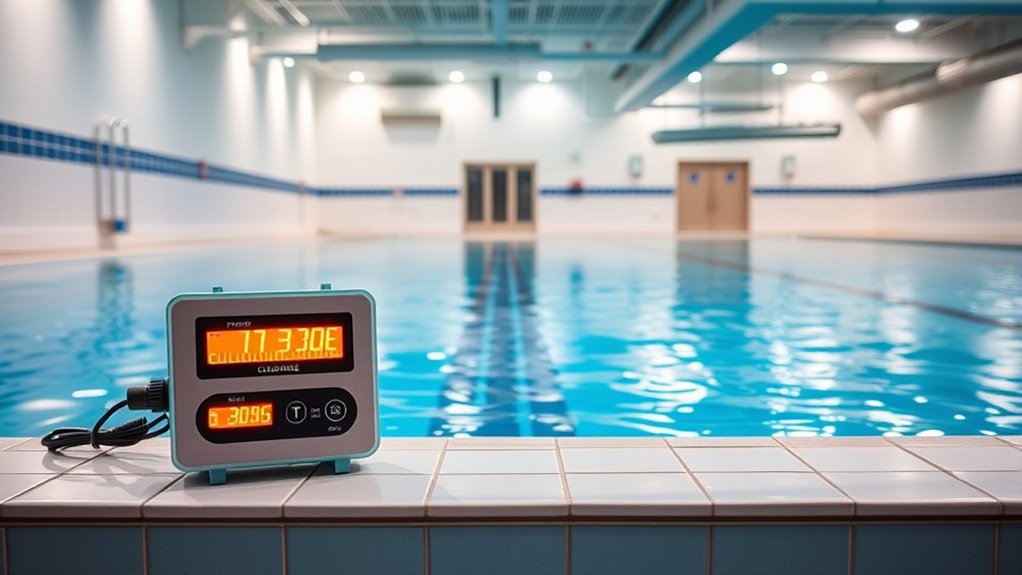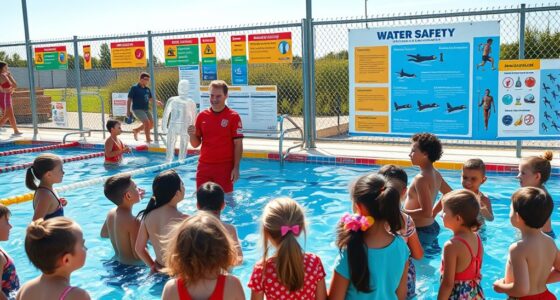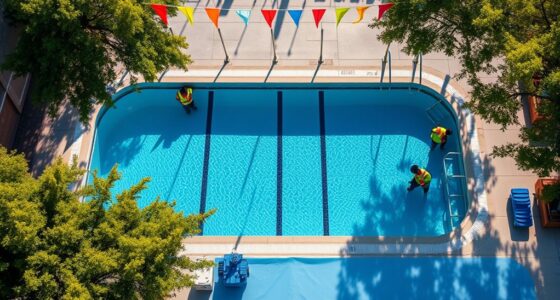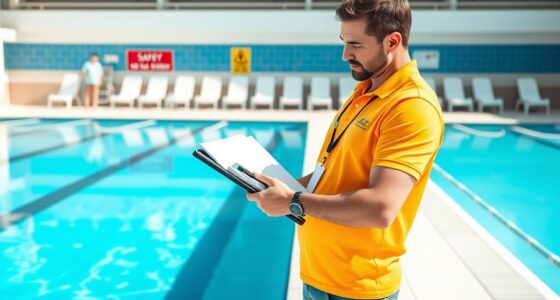To manage chloramine levels in indoor pools, regularly test and adjust pH levels to stay between 7.2 and 7.8, ensuring chlorine works effectively. Use aeration systems like fountains or air injection to help off-gas chloramines, improving water clarity and air quality. Encourage swimmer hygiene practices, such as showering before entering, to reduce organic matter. Consistent monitoring and proper chemical balance help keep water safe and inviting—learn more about optimizing your pool’s chemistry and aeration sources next.
Key Takeaways
- Implement aeration systems like fountains or air-injection devices to promote chloramine off-gassing.
- Maintain pH levels between 7.2 and 7.8 for optimal chlorine effectiveness and reduced chloramine formation.
- Regularly monitor and adjust chlorine and chloramine levels with automated testing systems.
- Enforce swimmer hygiene policies, such as showering before entering the pool, to minimize organic contaminants.
- Use complementary disinfection methods like UV or ozone to enhance chloramine breakdown and improve water quality.
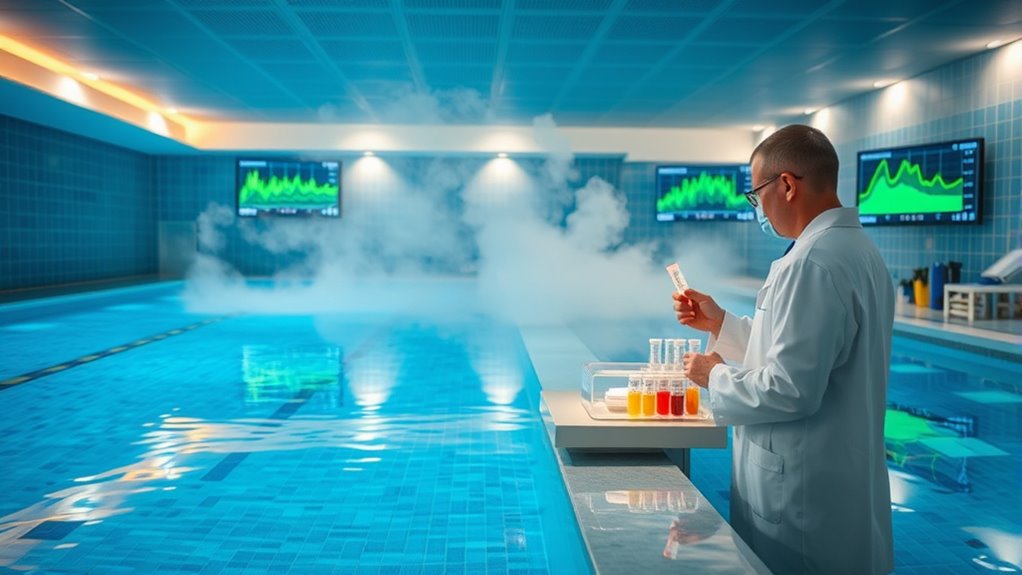
Indoor public pools often struggle with chloramine buildup, which can cause discomfort and health issues for swimmers. Chloramines form when chlorine reacts with organic matter like sweat, urine, and skin cells, creating a compound that’s irritating to the eyes, skin, and respiratory system. Managing these levels is essential to maintain a safe and comfortable swimming environment. One effective way to do this is through pool aeration. By introducing air into the water, you enhance the removal of chloramines, as aeration promotes off-gassing of these compounds. This process helps to improve water clarity and reduce foul odors, making the pool more inviting. Proper aeration systems, such as aeration fountains or air-injection devices, are critical in increasing oxygen levels and stimulating the natural break-down of chloramines.
Alongside aeration, pH balancing plays a key role in managing chloramine levels. When the pH of the pool water is too high or too low, chlorine becomes less effective at disinfecting and neutralizing contaminants, leading to increased chloramine formation. Keeping the pH within the ideal range of 7.2 to 7.8 ensures that chlorine maintains its disinfectant power, reducing the buildup of chloramines. Regular testing and adjusting of pH levels with appropriate chemicals allow you to maintain ideal water chemistry. If the pH drifts outside the target range, chlorine’s ability to oxidize organic matter diminishes, and chloramine levels tend to rise, worsening discomfort for swimmers.
Another important aspect involves maintaining proper chlorine levels. Too little chlorine allows organic matter to accumulate and react, increasing chloramine production. Too much, and you risk skin and eye irritation. You need to find a balance—adding enough chlorine to effectively sanitize without creating excess chemical reactions. Using stabilized chlorine or alternative disinfection methods, such as UV systems or ozone, can help reduce chloramine formation further.
Monitoring and controlling these factors consistently is essential. Automated systems that measure pH, chlorine, and chloramine levels can provide real-time data, enabling quick adjustments. Additionally, encouraging swimmers to shower before entering the pool and enforcing policies to minimize organic load can greatly lower chloramine formation. Incorporating advanced monitoring techniques can further optimize water quality management. Combining proper pool aeration with diligent pH balancing, consistent chemical management, and good hygiene practices creates a healthier indoor swimming environment. This comprehensive approach not only reduces chloramine levels but also improves water quality, ensuring swimmers enjoy a safe and comfortable experience.
Frequently Asked Questions
How Does Chloramine Affect Swimmer Health Long-Term?
Chloramine toxicity can cause long-term health issues for swimmers, especially affecting respiratory health. You might experience ongoing respiratory effects such as asthma or bronchitis if exposed to high chloramine levels regularly. Over time, these effects can worsen, leading to chronic breathing problems. It’s important to monitor and manage chloramine levels to minimize these risks, ensuring a safer swimming environment and protecting your long-term health.
What Are the Signs of High Chloramine Levels in a Pool?
You can tell there’s high chloramine buildup in a pool when you notice a strong chlorine-like odor, which actually indicates chloramine presence, not clean water. Odor detection is a key sign, along with eye or skin irritation and respiratory discomfort. If the water feels cloudy or the smell persists despite proper chlorination, it’s a clear sign you need to address chloramine levels to confirm swimmer safety.
Can Natural Methods Reduce Chloramine Levels Effectively?
Yes, natural methods can effectively lower chloramine levels. You should consider using natural filtration systems that promote biological processes to break down chloramines. Additionally, enzymatic treatment helps by accelerating the breakdown of organic compounds responsible for chloramines, improving water quality. These approaches are eco-friendly, reduce chemical reliance, and maintain safe, clear water. Incorporate natural filtration and enzymatic treatments regularly to keep chloramine levels in check and ensure a healthy swimming environment.
How Often Should Chloramine Levels Be Tested?
Think of your pool like a busy kitchen; regular checks keep everything running smoothly. You should test chloramine levels at least twice daily, especially during peak use, to stay ahead of issues. Proper pH balancing helps reduce chloramine formation, so monitoring pH along with chloramine levels guarantees water stays safe and clear. Consistent testing prevents buildup, keeping swimmers happy and healthy.
Are There Alternative Disinfectants to Chloramine?
Yes, there are alternative disinfectants to chloramine, such as ozone, ultraviolet (UV) light, bromine, and hydrogen peroxide. These chemical alternatives can effectively disinfect pool water while reducing chloramine formation and associated odors. If you’re considering switching, consult with a water treatment specialist to guarantee proper implementation and safety. Using these options can improve water quality and swimmer comfort without relying solely on traditional chloramines.
Conclusion
As you walk past the shimmering surface of the pool, remember that keeping chloramine levels in check is your secret to a fresh, inviting oasis. With each careful adjustment, you’re like a skilled artist maintaining a crystal-clear canvas, free from the haze of unwanted chemicals. Your attention guarantees swimmers breathe easy and enjoy every splash. So, stay vigilant and keep the water sparkling—your pool’s inviting glow depends on it.
